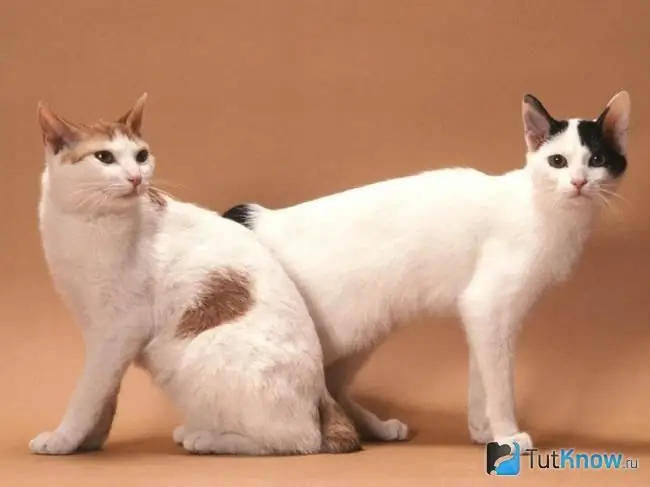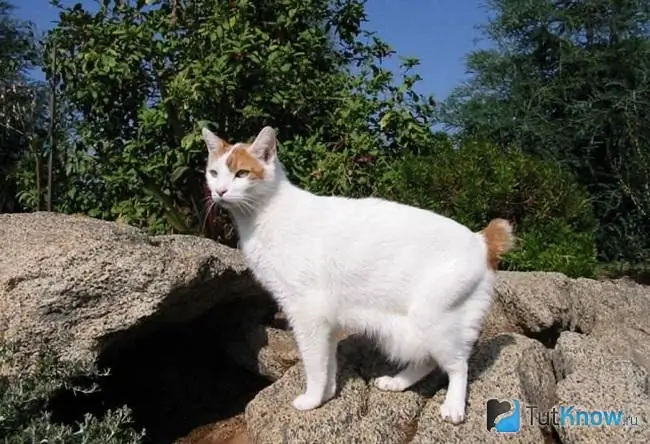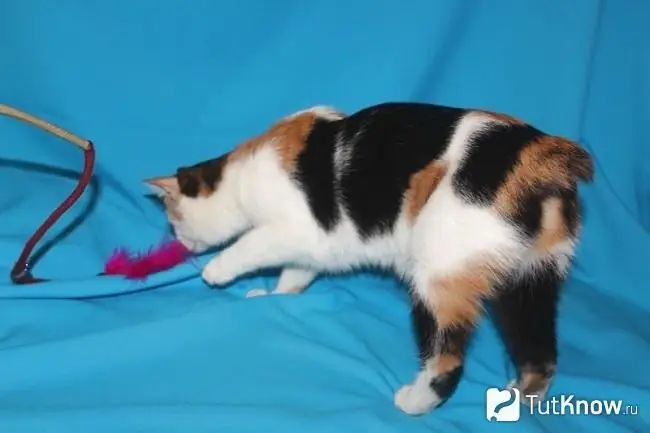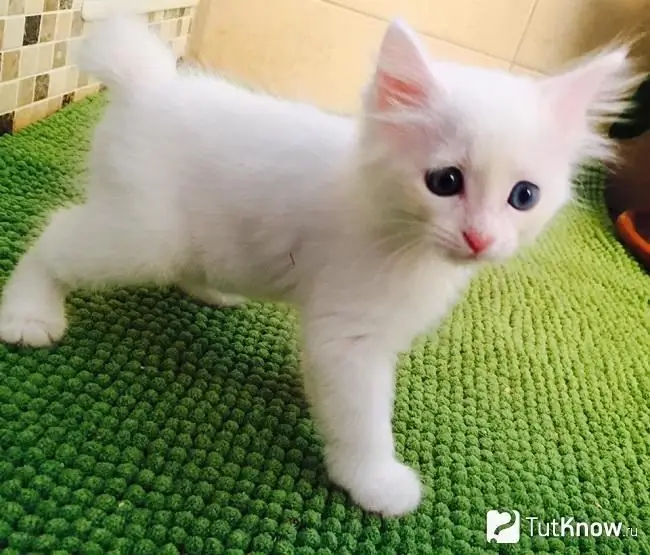The history of the origin of the Japanese Bobtail breed, the acquaintance of the world with amazing cats, the official recognition of cats as a separate breed, representatives of the breed in art and culture, popularity. The Japanese Bobtail is, in truth, one of the most extraordinary representatives of the feline world. There are certain features in their appearance that can be noticed at first glance, which gives this breed a unique flavor.
Japanese bobtails are even smaller than average seals, with a diminutive but stocky body and stable legs. What they have in common is a rather short tail process and the fact that most representatives of their breed have a different color of the irises. But not quite ordinary appearance is not their only advantage.
Such animals are very smart and affectionate, their temperament is not inherent in the usual arrogance and pride of cats, they are extremely cute and friendly creatures. Keeping such a pet in the house is a joy both for the eyes and for the soul. It is difficult to find a more faithful, devoted and at the same time cheerful four-legged friend, besides, the Japanese for many years believed that cats bring good luck and drive away all troubles, so who knows, maybe they are right and bringing this short-tailed Japanese to the house. Bobtail with different eyes, you will find not just a friend and companion, but also the strongest amulet against all troubles and troubles.
History of Japanese Bobtail cats

On the territory of the homeland of these seals in Japan, everyone knew about them and from very ancient times, we can say that since the 9th-10th centuries of our era. It was then that these purrs first set foot on the lands of the Land of the Rising Sun, sailors from China brought them there, and even then the pets conquered not only the locals with their beauty and originality, but also the Emperor Ichidze himself, who had a cat with a pompom tail named Mebu no Otodo.
It was this ruler who issued a decree, which said that all residents would release their domestic cats into the streets, so that they would defend their native lands from rodents. People had no right to disobey their lord, and humbly obeyed the order, while almost 2000 already homeless representatives of the feline world roamed the streets of Japan. Animals perfectly coped with the task and destroyed all, well, or almost all rodents, which earned not only the love and respect of people, but, we can say that cats (and Japanese Bobtail as well) became the country's talismans. They were taken care of, they were revered at the level of all citizens of the country, cats were adored to some extent, and even more so bobtails.
In Japan, there is a belief that all evil and negative energy accumulates in the tail of a cat, for this reason a barbaric tradition of chopping off cats' tails arose among the inhabitants of the country of the Rising Sun, so the Japanese, as they thought, got rid of troubles and difficulties. Later, mother nature took pity on the poor, innocent, animals and cats in some strange way transformed and they began to give birth to kittens immediately with a shortened tail.
The locals were shocked. Almost immediately, their attitude towards felines changed dramatically. They also revered cats with long tails, they just got rid of him as a source of their troubles, then one can only imagine how appreciated the pets with a short tail, which is not injured and not surgically removed, he just has such an anatomical structure from nature.
For a long time, Japan was an isolated country, tourists and scientists did not go there, and for this breed of Japanese Bobtail it was very profitable, since no one tried to change something in them, to deduce a certain standard. The Japanese in their aboriginal seals were absolutely satisfied with everything, so the cats interbred only with their own kind, thanks to which their features in the form of a short tail process have survived to our time in their original form.
Discovery of the Japanese Bobtail cat breed

No matter how strongly and enthusiastically the Japanese residents did not love and respect their cats, they were in no hurry to show them to the world, either they did not consider them purebred or worthy to be called such, or they simply did not want to share their national heritage with the inhabitants of other countries. Already in the post-war period, around the 50s of the last century, American soldiers brought home several specimens of Japanese Bobtail with a shortened tail, but then the people of the United States admired them and that's it.
But after not so long 12-15 years, in 1968, the cat breeder Elizabeth Freret from the USA, being in Japan, could not resist the sight of unique Japanese Bobtails and brought home three representatives of the Japanese aboriginal breed at once. At the same time, she began to implement a project for breeding this breed and directed all efforts to ensure that Japanese Bobtail received all the necessary documents with seals and signatures of members of prestigious felinological associations. And success was not long in coming.
Japanese cat breeders, having learned about the breeding program of their local cats in America, also set to work and at the same time did everything possible and impossible to assign cats the status of "purebred".
Recognition of Japanese Bobtail cats

Neither the Japanese nor the Americans had a chance to report any special efforts to make these purrs deservedly appreciated by the members of the commission of international feline organizations. Already in 1976, the Japanese Bobtail breed received its well-deserved blessing from such a prestigious authority as the CFA (Cat Fanciers Association), which in turn is one of the members of the World Felinological Congress. In the same year, the animals of this species were recognized as a separate breed and the workers of the Canadian Agricultural Federation. But there is one "but". All these organizations recognized only Japanese short-haired bobtails, long-haired cats of this breed received their recognition 20 years later, around the mid-90s of the XX century.
After the first documentary evidence of the existence of the Japanese Bobtail breed, such cats every year received new titles and approvals from other feline organizations with world names. Thus, the breed is officially recognized by ACF (Australian Cat Fanciers Federation), FIFe (International Cat Federation), WCF (World Cat Federation), NZCF (New Zealand Cat Fancy), SACC, TICA, LOOF, CCCA.
As soon as all these organizations adopted and approved the variety, then a kind of law was passed that prohibits any experiments with the breed, in no case should the Japanese Bobtail be crossed with representatives of other types of cats. Most likely, felinologists are most afraid of losing such a specific genotype, which is manifested by the unusual tail of cats.
Japanese Bobtail in culture and art

For the reason that the inhabitants of the Land of the Rising Sun were very anxious about their local cats, the fact that they perpetuated them in every possible way in their culture is not something strange and unusual.
Coming to Japan, in almost every souvenir shop, you can see a figurine of a cat quite similar to a Japanese Bobtail with a raised paw. This traditional souvenir has been popular among the Japanese for many years, such a cat is called "Maneki-neko", which means "Alluring cat" in Japanese. Shopkeepers usually place Maneki-neko at the entrance, so they invite people to come to them. It is believed that this statuette not only invites visitors with its raised paw, but also brings the owner a good profit and success. Some people put such figures in front of the front door, thus showing their hospitality. And the prototype of the most famous souvenir mascot is none other than a Japanese bobtail cat.
With the development of modern technology and print media, people also did not forget about their four-legged characters, and Japanese cats with a short tail very often become heroes of Japanese comics and anime. Even the world famous brand "Hello Kitty" chose a cute and attractive face of a Japanese bobtail as a logo.
Scientists with world names also did not ignore our furry heroes, for example, Engelbert Kempfer, a famous German naturalist, doctor and traveler in his book "Japan", whose publication dates back to 1702, could not fail to mention one of the most beautiful and important sights of the country - Japanese Bobtail.
The popularity of Japanese bobtails

Despite the fact that the native land of the representatives of this breed is Japan, most of the nurseries that breed the breed are concentrated in the United States. These cats are quite a good way of income for Americans, since the demand for original cats in America is very large, there they are considered a popular and elite breed, which cannot be said about European countries.
In Europe, this breed of cats is considered rare and not because no one wants to breed them, the reason is that for some reason these fluffy symbols of Japan could not win the hearts of Europeans. But after all, no one can predict what tomorrow has in store for us, perhaps these cats are still destined to achieve goodwill and glory on the European continent.
Learn more about the cat from the video below:






